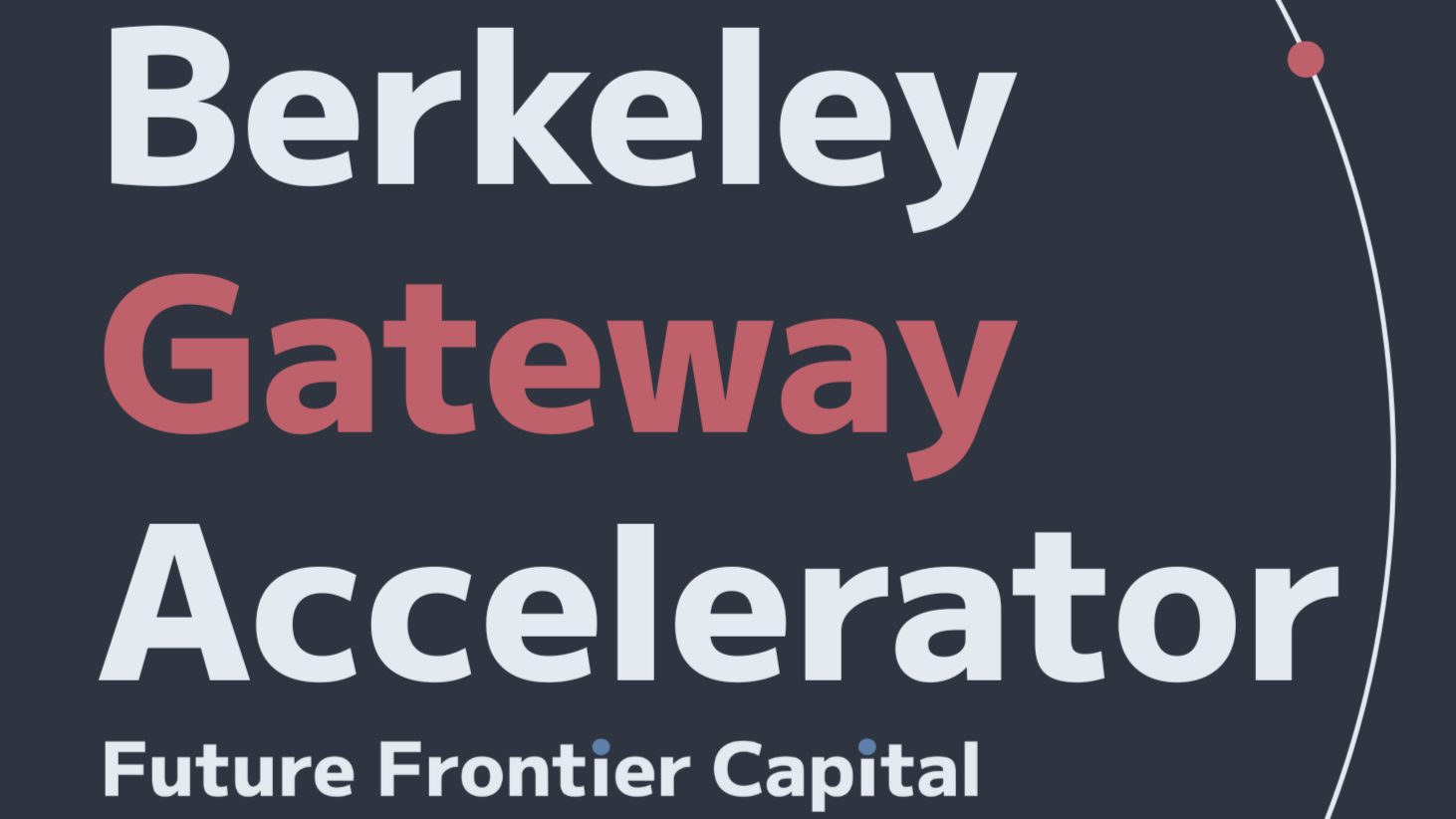Notes from the Technology Frontier - October 2025
Welcome to the latest transmission of Notes from the Technology Frontier - October 2025 Edition, where we share updates, ideas, and reflections from across Future Frontier Capital and our partners shaping the future of deep tech.
Introducing the Berkeley Gateway Accelerator: Where Global Deep Tech Innovation Meets Silicon Valley Scale
The Berkeley Gateway Accelerator is Berkeley’s premier deep-tech launchpad, designed specifically for visionary founders seeking to establish and scale their startups in the Bay Area market.
This five-month immersive residency combines furnished housing and office space Berkeley, California with a modular curriculum tailored to each company’s development stage.
Each startup is paired with a full-time UC Berkeley Entrepreneurial Fellow, embedded as an extension of the founding team, and gains access to a 400+ member global mentor network of experts, investors, and founders.
Founders receive the right kind of support at the right time, with a focus on IP strategy, regulatory navigation, partnership building, fundraising and market validation. The Gateway’s small, focused cohorts and deep-tech-specific frameworks ensure that every company leaves with a defensible foundation, validated market momentum, and the strategic infrastructure for U.S. expansion.
📘 Program Brochure
🧩 Gateway Playbook
Perspectives on Deep Tech Innovation
Insights on how deep-tech innovation evolves — and what it asks of us.
The Deep Tech Valley of Death
In The Deep Tech Valley of Death, Matt Rappaport describes the fragile space where many deep-tech ventures falter — between breakthrough and business. He explains that progress in these fields depends less on isolated innovation and more on building the right scaffolding: institutions, processes, and capital systems that can sustain long scientific development cycles.
The essay underscores why deep tech requires different operating logic — one that balances rigor, patience, and long-term value creation over rapid iteration.
Demystifying Deep Tech: Real Solutions for Real Problems
In Demystifying Deep Tech: Real Solutions for Real Problems, Matt distinguishes traditional technology innovation and deep technology. He writes that while conventional tech often optimizes convenience, deep tech tackles fundamental human and planetary challenges — in energy, materials, agriculture, and health.
These ventures demand technical depth, interdisciplinary collaboration, and systemic thinking. They are not about chasing speed or valuation, but about creating breakthrough solutions with generational impact — innovations that reshape industries, strengthen societies, and redefine what progress means.
The Mosaic of Minds: Interdisciplinary Collaboration in Deep Tech
In The Mosaic of Minds, Matt reflects on how deep tech succeeds when disciplines, generations, and cultures overlap. He argues that no single field — not engineering, business, or policy — can alone bring a scientific breakthrough to market. True progress happens when teams are designed as mosaics of expertise and perspective.
This blog echoes the foundation of Gateway’s model: bringing together founders, researchers, and entrepreneurial fellows from diverse backgrounds to create collective intelligence that accelerates meaningful innovation.
Mapping the Edge of Deep Tech
Industry insights and analysis from the evolving frontier.
Space Solar (SBSP): Hype, Hope, and Hidden Hurdles
By Riley Noel
The concept of space-based solar power (SBSP) has long inspired big thinking—imagine huge solar arrays in orbit, beaming clean energy straight to Earth 24/7. But is it the next big energy breakthrough or just sci-fi with extra steps?
How It Works: Transmission 101
Here’s the quick version: solar panels in space collect sunlight, convert it to microwave energy, beam it down via phased array antennas or lasers, and Earth-based rectennas (rectifying antennas) turn that beam back into usable electricity. Sounds wild—but the tech, while complex, is becoming more feasible thanks to adjacent industries.
Innovations in launch systems (think: SpaceX), satellite manufacturing, and in-orbit robotics are cutting costs across the board. As the space sector scales up, these tools make SBSP cheaper to deploy and maintain.
Can We Afford It? Getting Closer
Historically, SBSP was just too expensive—especially the microwave transmission tech. But that’s changing. As demand rises for satellite comms, 5G, and military beaming systems, key components like phased arrays and gallium nitride semiconductors, and space launches are getting cheaper. Industry watchers say microwave beaming and laser costs could also drop over the next decade. That shift could finally flip SBSP from a science project to serious infrastructure.
The Musk Critique
Elon Musk has been blunt: “You'd have to convert photon to electron to photon back to electron. What's the conversion rate?” It’s a fair question. Every one of those steps loses energy. Solar panels in space convert sunlight into electricity, which is then turned into microwaves, sent to Earth, and converted back into electricity. Musk argues we’re better off with big solar farms on Earth, pointing out that just a few square kilometers of solar in Texas could power the U.S.
But the Renaissance is Real
Still, companies like Virtus Solis are rethinking space solar. Instead of building huge, unwieldy structures, they’re going modular—smaller components that can be tested, launched, and iterated over time.
The Rectenna Bottleneck
The biggest hang-up? The receivers on Earth. Rectennas are crucial to optimize thermodynamic efficiency, but are woefully underdeveloped, with little funding from other industries. A few university breakthroughs have popped up, including a promising design from UC Boulder published in Nature, but startup and patent activity here is thin. If someone cracks this, they could meaningfully tip the scales on feasibility for SBSP deployment.
Uncertainties aside, A few U.S.-based players are stepping in:
Virtus Solis – Modular SBSP systems with demo flights on the horizon.
EMROD – Long-range wireless power transmission, Earth-to-Earth for now.
AetherFlux – Early player with big ambitions in California, using portable ground receivers to solve transmission.
PowerLight Technologies – Laser-based beaming with space/defense ties.
Solestial - Flexible space-ready solar panels optimized for manufacturing costs.
Near-Term Win: Powering Space First The best place to start might not be Earth. Space-based infrastructure—satellites, orbital factories, and future stations—needs reliable, constant energy. Solar power is already the primary method of powering space structures, but having an external solar power network in space could reduce risk of interference or damage caused by on-unit solar, while optimizing power production and array-scaling potential for flexible power load response. Notably, using solar arrays in orbit to power these directly sidesteps the entire beam-to-Earth challenge and proves the concept in a lower-risk environment. It’s less sexy, but way more doable in the short term.
The Wild Card: State-Backed Investment
Private markets might hesitate, but governments don’t always need a quick ROI. China’s already investing in SBSP and seems willing to take the risk. That could tilt the playing field fast.
Verdict: TBD
SBSP isn’t obviously doomed or obviously destiny. The science is solid, but the business case is still catching up. Watch this space—especially the unsexy but vital parts like rectennas.
Resources:
· Space Power Beaming Science Overview
· Caltech In-Space Power Transmission
Want to learn more about the Berkeley Gateway Accelerator?
Visit our program overview or reach out to us at contact@futurefrontier.vc
We're always eager to hear from exceptional founders, experienced advisors, and anyone passionate about transforming breakthrough science into breakthrough companies.
Follow our journey as we work to bridge the gap between innovation and impact, one transformative technology at a time.
Echoes From the Edge
1. Takuya Kuroda - Car 16 15 A
2. Polyrhythmics - Twice Baked
3. Ornette Coleman - Open to the Public
Future Frontier Capital, 1600 Shattuck Ave Suite 114, Berkeley, CA 94709, USA
Powered by Squarespace






